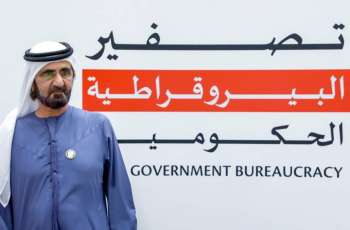DUBAI, (Pakistan Point News - 05th Dec, 2018) The Arab Strategy Forum, in collaboration with Al-Ahram Centre for Political and Strategic Studies, today issued a report that estimates the total cost of Iran’s nuclear programme to have exceeded US$500 billion since 2002.
It is one of many annual reports and studies published by the Arab Strategy Forum that is set to take place on 12th December 2018 in Dubai.
Launched at a panel discussion ahead of the Arab Strategy Forum 2018, the report, titled ‘The Economic Costs and Consequences of Iran’s Nuclear Programme’, found that international economic sanctions have cost Iran more than US$500 billion to date. Furthermore, the costs of developing and operating infrastructure and facilities for the programme have added some US$50 billion to the bill.
Led by Dr. Sultan Mohammed Al-Nuaimi, Associate Professor at Abu Dhabi University and Expert on Iranian Affairs, the panel discussion drew the participation of prominent academics and media personalities. Commenting on the report, Dr Al-Nuaimi said, "These gatherings of experts ahead of the event provide an ideal platform to discuss the reports of the Arab Strategy Forum 2018 that add value to the Forum. They present researchers with an opportunity to dig deeper into the report and converse with peers, who can offer new perspectives."
"The report calculates the costs of Iran’s nuclear programme, divided into two categories – direct expenditure on infrastructure and operations, and indirect economic sanctions. The document also examines the consequences of the programme in terms of economic hardship among the population," he added.
The report states that the construction of the Bushehr Nuclear Power Plant accounted for the majority of the nuclear infrastructure costs in Iran’s nuclear programme. Consequently, once completed, the total cost of constructing the plant could reach as much as US$12 billion, making it one of the most expensive nuclear power plants in the world, despite the plant’s likely limited technical capabilities, surpassed by plants that have carried less than half of Bushehr’s total price tag.
The report details the cost of building and operating the Bushehr Nuclear Plant as well as related facilities, including uranium mines, processing facilities, enrichment facilities, nuclear fuel production infrastructure, and isotope separation facilities. It also outlines the stages of the international economic sanctions on Iran since the discovery of its secret nuclear facilities in 2002.
Due to the new US sanctions following the US administration’s withdrawal from the Iran Nuclear Deal, economic losses are expected to surge in 2018.
The US administration has declared that the re-imposed sanctions on the Iranian economy will span two phases. The first phase, in effect since August 2018, sanctions Iran’s trade in gold and other precious metals, raw materials, aluminium, and coal, as well as the trade in Iranian Rial and investment in Iranian bonds abroad, and the country’s automotive industry. The second phase took effect in November 2018 and includes sanctions on the Central Bank of Iran as well as the financial, shipping, and energy sectors with the aim of bringing Iran’s oil exports down to zero.
The adverse economic situation in Iran has led to frequent protests in various regions across the country throughout the past years, with protestors citing inflation, unemployment, poverty, and corruption as their Primary concerns.
The report highlights how the ongoing sanctions on Iran have limited foreign direct investment, FDI, flow to the country. Moreover, foreign companies have cancelled new investment contracts worth tens of billions of Dollars, especially in the energy sector that needs between US$130 billion and US$300 billion of new investments to maintain productivity until 2020.
As a result, unemployment rates in Iran have risen, especially among youth. About one-third of the country’s young people have no job opportunities, which fuels their frustration with the local economic situation. The value of the Iranian rial has also plummeted due to sanctions, especially the recent US sanctions, which led to a surge in the price of the US Dollar on the black market to IRR112,000 in August 2018, compared with IRR36,000 on the official market in early 2018, before the new sanctions regime. The inflation rate has witnessed unprecedented levels and is projected to reach an annual average of 203 percent by end-2018 according to some estimates.
Various economic sectors in Iran were affected by the sanctions and their consequences. Notably, the oil sector, which the country’s economy heavily relies on, has seen production and exports decline. The Iranian industrial sector, another target of the recent US sanctions, has also suffered. The agricultural industry has borne the negative impact of insufficient automation and the absence of modern technologies, and, to make matters worse, the local industrial sector is unable to provide an alternative. International sanctions have also led to the deterioration of Iran's infrastructure due to the drop in public revenue from oil exports and the reluctance of foreign companies to invest in the sector. Also, the sanctions have restricted knowledge exchange and imports of modern equipment, which has adversely affected the technology sector. This has resulted in heavy wear of Iran's infrastructure, especially energy networks, which has caused significant annual losses due to reduced efficiency and productivity.
The report notes that the effectiveness of the US sanctions will ultimately depend on the response of international players, both governments and companies. European companies are expected to respond to the sanctions to avoid potential losses if they have not already done so, while some Asian companies may continue to work with Iran or even expand their collaboration unless the US administration decides to pressure Asian governments to use other bilateral issues.
Access to accurate official data on the direct financial cost of Iran’s nuclear programme and the economic impact of international sanctions on the country is difficult to acquire. These statistics are only available to a very limited number of prominent Iranian officials. Thus, attempts to monitor the overall cost of Iran’s nuclear programme, both direct and indirect, are the results of expert estimates based on the available official and semi-official data, in addition to international benchmarks and approximate calculations to fill the gaps in the required information.
At the initial stage of the sanctions, all investments were disregarded and therefore were not recorded as losses, instead considered as missed opportunities for the Iranian economy. However, the losses in FDI inflow to Iran since its nuclear crisis far exceed the setbacks in FDI inflow during pre-crisis years, as they exclude the annulled investment plans of international companies. This is most prominent in the oil sector, which benefited from a rapid rise in oil prices during the previous decade that incentivised energy companies to increase their investments in oil-rich countries. The annulled investment contracts in Iran’s energy sector until 2010 are estimated at US$60 billion.
In general, the loss of investment opportunities due to ongoing sanctions during the Iranian nuclear crisis coincides with the Iranian government’s estimate that its energy sector needs US$130 billion to US$145 billion of new investments by 2020 just to maintain current production capacity. Other Iranian official estimates raise the number to US$300 billion.
The report references the World Bank’s prediction that Iran needs to create a million new jobs every year from 2015 to 2020 only to keep unemployment at 10 per cent. However, the country’s economy is failing, with unemployment rising to 12.1 per cent in Q1 2018, according to official Iranian data, which could mean real unemployment rates are several percentage points higher.
Unemployment has a particularly negative impact on young people in Iran, which might explain why they constitute the majority of the participants in the recent waves of protests across Iranian cities.
The estimated total losses to the Iranian economy between 2012, when the sanctions tightened, and 2016 range between US$310 billion and US$390 billion of potential aggregate output. This is the result of several factors, including the decline of oil exports and FDI inflow, as well as the restrictions on knowledge exchange in the technology field.




